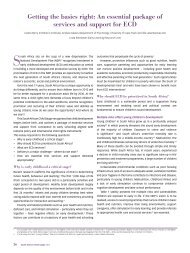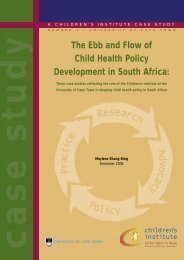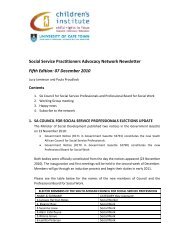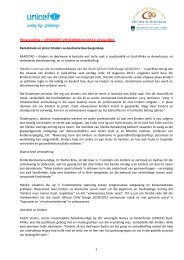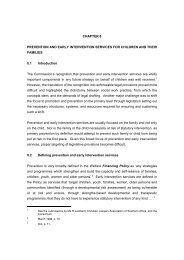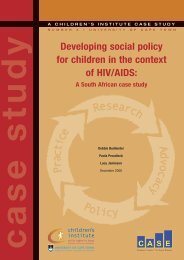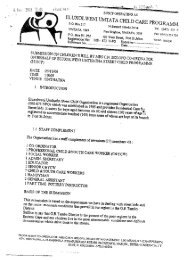Chapter 13 - Children in need of special protection - Children's ...
Chapter 13 - Children in need of special protection - Children's ...
Chapter 13 - Children in need of special protection - Children's ...
You also want an ePaper? Increase the reach of your titles
YUMPU automatically turns print PDFs into web optimized ePapers that Google loves.
540<strong>13</strong>.2.4.3 Malnutrition and <strong>in</strong>fectionThere is a direct and cyclical l<strong>in</strong>k between malnutrition and <strong>in</strong>fection. Inadequate dietary <strong>in</strong>takecan cause weight loss or growth failure <strong>in</strong> children, which <strong>in</strong> turn leads to low nutritionalreserves. With virtually all nutrient deficiencies there is a lower<strong>in</strong>g <strong>of</strong> immunity; with deficiencies<strong>in</strong> prote<strong>in</strong> energy and vitam<strong>in</strong> A, <strong>in</strong> particular, there may be progressive damage to mucosa,which lowers resistance to <strong>in</strong>vasion and colonisation by pathogens.Lowered immunity and mucosal damage are major contributors to the lower<strong>in</strong>g <strong>of</strong> a body'sdefences. In such circumstances, the potential for contract<strong>in</strong>g diseases is not only <strong>in</strong>creased,but the severity and duration <strong>of</strong> diseases are also likely to <strong>in</strong>crease. The disease process itselfexacerbates the loss <strong>of</strong> nutrients, both by the host's metabolic response, and by the loss fromthe <strong>in</strong>test<strong>in</strong>e. Many diseases are also associated with a loss <strong>of</strong> appetite and other disabilitieswhich contribute to a further lower<strong>in</strong>g <strong>of</strong> dietary <strong>in</strong>take. The proportion <strong>of</strong> deaths due to PEM <strong>in</strong>children under 5 years <strong>of</strong> age is not known. However, among poor children PEM is known tocontribute considerably to mortality associated with diarrhoeal diseases, respiratory <strong>in</strong>fectionsand measles.<strong>13</strong>.2.4.4 Programmes to improve child malnutritionIn a 1994 report on the status <strong>of</strong> nutrition <strong>in</strong> South Africa, the National Nutrition Committee foundthat a number <strong>of</strong> primary factors were contribut<strong>in</strong>g to the development <strong>of</strong> under-nutrition. Thesewere as follows:(a)The availability and quality <strong>of</strong> health servicesAccess to primary health facilities was found to be a major factor <strong>in</strong> the prevention <strong>of</strong>malnutrition. A shortage <strong>of</strong> cl<strong>in</strong>ics and staff, <strong>in</strong>appropriate tra<strong>in</strong><strong>in</strong>g, a lack <strong>of</strong> emphasis on growthmonitor<strong>in</strong>g and promotion, variable immunisation coverage and the low prevalence <strong>of</strong> breastfeed<strong>in</strong>g all contribute to the high prevalence <strong>of</strong> malnutrition among <strong>in</strong>fants and children. Thesefactors are compounded by unclean water and an <strong>in</strong>sanitary environment.(b)Car<strong>in</strong>g capacityWomen assume the primary responsibility for the care <strong>of</strong> children, and e<strong>special</strong>ly very young



